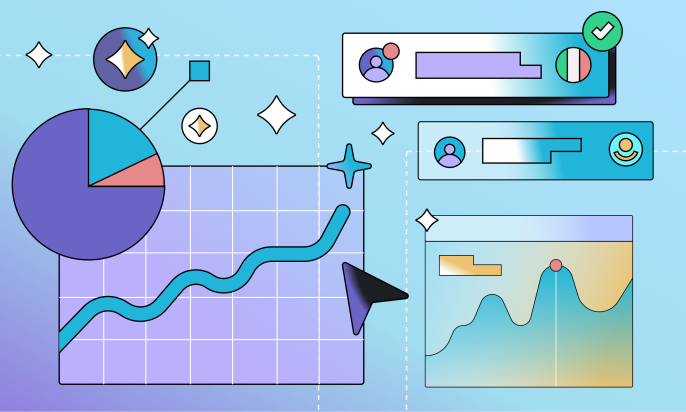B2B marketing is changing—fast. In the past, B2B conversions funnels were all about engaging users early and carefully guiding them through the funnel towards a sale.
Now? Most prospects don't contact a company until they're almost ready to buy.
This means those B2B conversion funnel strategies you've been relying on might not be effective anymore.
If you want to keep B2B sales prospects in the funnel, you need more data.
Luckily, Leedfeeder has you covered. Our tool tracks what companies visit your site, what pages they view, and a whole lot more.
Note: Leadfeeder is a site tracking tool that identifies site visitors and helps B2B companies track leads throughout the funnel. Sign up for your free, 14-day trial.
Why do we care about B2B conversion funnels anyway?
Before we dig into how to improve your conversion funnel, let's talk about why we care about them.
The most obvious reason is we all want more conversions, right?
The issue is most marketing and sales teams tend to assume there's only one way out of the funnel— the bottom.

In reality, leads leak out of the funnel at all stages. Some people refer to this problem as "the dark funnel."
You don't care about some of those leaks, of course. If you sell software to B2B companies, you don't really care about the B2C companies that don't come back to your site.
But a lot of those leaks are good-quality leads that could have become loyal customers. And lost leads = lost revenue.
Are you ready to plug those leaks?
<div style="width:100%;height:0;padding-bottom:67%;position:relative;"><iframe src="https://giphy.com/embed/lVBtp4SRW6rvDHf1b6" width="100%" height="100%" style="position:absolute" frameBorder="0" class="giphy-embed" allowFullScreen></iframe></div><p><a href="https://giphy.com/gifs/lVBtp4SRW6rvDHf1b6">via GIPHY</a></p>
We can help. Here's how Leadfeeder can optimize your B2B conversion funnel each step of the way.
5 ways to improve every step of your B2B conversion funnel with Leadfeeder
Leadfeeder tracks which companies visit your website and what they do when they get there. That information can help refine your conversion funnel, track leads, and so much more.
Ready to say goodbye to your leaky conversion funnel?
1. Better understand who your audience is
Do you know who your audience really is? 👀
You might not. If your conversion funnel is targeting (or filtering out) the wrong audience, you could be wasting time and money.
Start by reviewing your buyer persona. Does it match your current goals?
If not, it's time to refresh it.
Then, compare your buyer persona to the leads you see in Leadfeeder. Once you've installed our tracking code, you'll be able to see what companies visit your website and other information, such as:
Revenue
Location
Language
Industry
Company website
Website visits
Compare the leads coming to your site to your buyer persona. Do they match? If not, your marketing campaigns might be attracting the wrong prospects to your conversion funnel.
2. Capture contact information without gating content
Gated content used to be the gold standard for gathering B2B leads—but the practice is dying off.
That's because it isn't as effective as it used to be.
Instead, many companies (including ours!) are shifting to demand generation strategies, which focus more on educating prospects and ungating content.
So, how do you capture contact information without making your audience fill out forms?
That's where Leadfeeder comes in.
We don't just track which companies visit your website; we also track what pages they visit and look for the most relevant contact at that company.

See that "contact" menu? That's where you'll find all the info you need to reach out—no content gating required.
Pro tip: If you integrate our platform with LinkedIn, you can also retarget site visitors on LinkedIn.
3. Track the most effective content on your site—so you can make more
Most conversion funnel optimization strategies focus on moving prospects from the top of the funnel to the bottom. To find the most effective content on your site, you'll actually want to work backward.
Note: You'll need a bit of historical data for this strategy.
Once you've had Leadfeeder running for a while, create a goal feed filter and set it to track specific content.
Depending on your efforts, this might be a white paper download, visiting your pricing page, or even hitting a specific landing page.
Here are the different types of goals you can track:

Let's say you want to track people who read a specific blog post—say about B2B conversion funnels!
Once the goal filter is set up, you'll see how many prospects read your post.
How many of those leads converted? Which has the highest LTV? And—finally—what other pages did those high LTV customers visit?
(Another method is to make a list of closed deals with high LTV and then use Leadfeeder to see what pages they viewed. However, you'll need to integrate your CRM with Leadfeeder to do this.)
Once you have a list of content that your highest value customers love, compare them. Are they on a specific topic? Are they how-to guides, or listicles, or do they focus more on industry news?
Use that information to help guide your content creation.
When you provide more of the content your prospects want, they're more likely to stay in your funnel—and hopefully convert.
4. Reduce funnel friction by reaching out at the right time
Funnel friction is one of the quickest ways to tank conversion rates.
Users have more options than ever, so when a page or tool doesn't work the way they expect, they're likely to go elsewhere.
Leadfeeder filters can help you spot when prospects reach a specific stage in the funnel and then drop out so you can follow up.
Let's say a customer visits your demo page but doesn't sign up. Using Leadfeeder, you can create a filter tracking leads who visit your demo page but don't fill out your form. This allows sales to reach out and pull them back into the funnel.
Maybe there wasn't a good time available, maybe your demo is recorded and they want a live version. There's only one way to know — and that's to ask.
For example, you might create feeds to track when users:
Visit a landing page, but don't complete the form
Visit your pricing page, but don't convert
Watch a specific video
Visit your pricing page
Visit a high-value page (say, your services page) and your pricing page
Filters can be stacked, allowing you to get really granular.
Note: Here's how to create custom feeds.
5. Use automation to catch leaks faster
Say you want to know when visitors read two blogs, watch a specific video, visit your pricing page, and live in your service area.
You create a feed filter and login to check it every day. Now you're spotting prospects who are ready for outreach and catching leads trying to exit the funnel.
Nice.
But you're also busy. Checking in every day is a bit tedious, plus some leads need nurturing now, not in 16 hours.
Nothing a little automation can't fix.
Once you create your feed filter, make sure to set up your feed notifications.
New leads can be emailed to a specific person or posted in a Slack channel. If you integrate your CRM, we can create a new lead and assign it to the right sales team.
Use Salesforce? Automatically upload leads, even create and assign a new task. You'll never miss a lead again.
Got a leaky B2B conversion funnel? Leadfeeder can help.
Leaky B2B conversion funnels got you down? Our website tracking tool helps B2B companies see who visits their website and what actions they take.
If your business wants to improve conversions—and sales—you need more data. Leadfeeder provides the information you need to track leads, plug funnel leaks, and reach out at just the right time. Note: Sign up for a free trial and see how Leadfeeder can increase conversions.
Now that you're here
Leadfeeder is a tool that shows you companies that visit your website. Leadfeeder generates new leads, offers insight on your customers and can help you increase your marketing ROI.
If you liked this blog post, you'll probably love Leadfeeder, too.
Sign up







